Related Research Articles

The Territory of Ashmore and Cartier Islands is an uninhabited external territory of Australia consisting of four low-lying tropical islands in two separate reefs, and the 12-nautical-mile territorial sea generated by the islands. The territory is located in the Indian Ocean situated on the edge of the continental shelf, about 320 km (199 mi) off the northwest coast of Australia and 144 km (89 mi) south of the Indonesian island of Rote.

The Houtman Abrolhos is a chain of 122 islands and associated coral reefs, in the Indian Ocean off the west coast of Australia, about 80 km (50 mi) west of Geraldton, Western Australia. It is the southernmost true coral reef in the Indian Ocean, and one of the highest latitude reef systems in the world. It is one of the world's most important seabird breeding sites, and is the centre of Western Australia's largest single-species fishery, the western rock lobster fishery. It has a small seasonal population of fishermen, and a limited number of tourists are permitted for day trips, but most of the land area is off limits as conservation habitat. It is well known as the site of numerous shipwrecks, the most famous being two Dutch ships: Batavia, which was wrecked in 1629, and Zeewijk, wrecked in 1727.
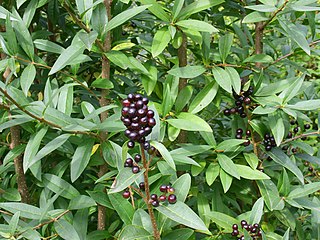
A privet is a flowering plant in the genus Ligustrum. The genus contains about 50 species of erect, deciduous or evergreen shrubs, sometimes forming small or medium-sized trees, native to Europe, north Africa, Asia, many introduced and naturalised in Australasia, where only one species, Ligustrum australianum, extends as a native into Queensland. Some species have become widely naturalized or invasive where introduced. Privet was originally the name for the European semi-evergreen shrub Ligustrum vulgare, and later also for the more reliably evergreen Ligustrum ovalifolium and its hybrid Ligustrum × ibolium used extensively for privacy hedging, though now the name is applied to all members of the genus. The generic name was applied by Pliny the Elder to L. vulgare. It is often suggested that the name privet is related to private, but the OED states that there is no evidence to support this.

The biodiversity of New Caledonia is of exceptional biological and paleoecological interest. It is frequently referred to as a biodiversity hotspot. The country is a large South Pacific archipelago with a total land area of more than 18,000 square kilometres (6,900 sq mi). The terrain includes a variety of reefs, atolls, small islands, and a variety of topographical and edaphic regions on the largest island, all of which promote the development of unusually concentrated biodiversity. The region's climate is oceanic and tropical.

The Florida Keys National Marine Sanctuary is a U.S. National Marine Sanctuary in the Florida Keys. It includes the Florida Reef, the only barrier coral reef in North America and the third-largest coral barrier reef in the world. It also has extensive mangrove forest and seagrass fields. The Florida Keys National Marine Sanctuary, designated in 1990, is the ninth national marine sanctuary to be established in a system that comprises 13 sanctuaries and two marine national monuments. The Florida Keys National Marine Sanctuary protects approximately 2,900 square nautical miles of coastal and ocean waters from the estuarine waters of south Florida along the Florida Keys archipelago, encompassing more than 1,700 islands, out to the Dry Tortugas National Park, reaching into the Atlantic Ocean, Florida Bay and the Gulf of Mexico.
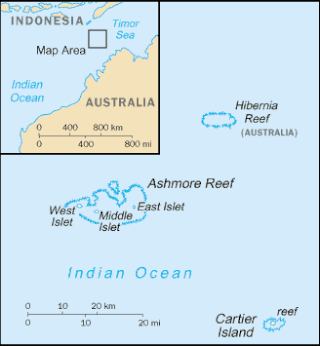
Cartier Island is an uninhabited and unvegetated sand cay in a platform reef in the Timor Sea, north of Australia and south of Indonesia. It is within the Territory of Ashmore and Cartier Islands, an external territory of Australia. The land area of Cartier Island is about 0.4 hectares. It is located at 12°31′S123°33′E, on the edge of the Sahul Shelf, about 300 kilometres (190 mi) off the north west coast of Western Australia, 200 kilometres (120 mi) south of the Indonesian island of Roti, and 70 kilometres (43 mi) south-east of Ashmore Reef.

Spinifex is a genus of perennial coastal plants in the grass family.

The wildlife of the Maldives includes the flora and fauna of the islands, reefs, and the surrounding ocean.

Geranium lucidum, commonly known as shining cranesbill or shining geranium or shiny geranium, is a herbaceous annual plant of the genus Geranium. It is native to Europe, western Asia and North Africa. It has been introduced to North America as a garden plant and in places, particularly the Pacific Northwest, has become naturalised and is viewed as an invasive species and noxious weed.

East Island is one of three islets of Ashmore Reef, which is a part of Ashmore and Cartier Islands. It is located at 12°15′S123°05′E, about midway between Australia and Timor. It is often referred to as East Islet, a name that is used, for example, in The World Factbook; the islet's gazetted name is, however, East Island.

North Island is the northernmost island in the Houtman Abrolhos, a coral reef archipelago in the Indian Ocean off the coast of Mid West Western Australia. Located about 14 km (9 mi) from the nearest island group, it is one of the largest islands in the Houtman Abrolhos, and one of the few to support dune systems. It has relatively diverse flora dominated by chenopod shrubs and fauna that includes the introduced tammar wallaby, around seven species of reptile, and about 15 resident bird species.
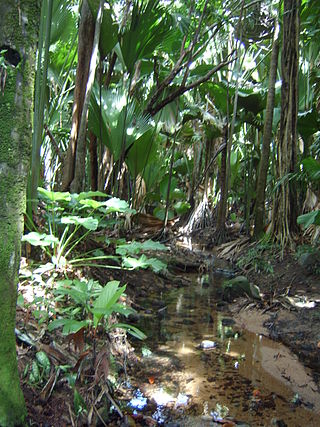
The wildlife of Seychelles comprises the flora and fauna of the Seychelles islands off the eastern coast of Africa in the western Indian Ocean.

Pigeon Island is a small island located need the middle of the Wallabi Group of the Houtman Abrolhos, an archipelago off the coast of Western Australia. It is almost entirely given over to western rock lobster fishers' camps, and as a result is far more disturbed than most other islands in the archipelago. A nearby island also seasonally populated by fishers is named Little Pigeon Island, hence Pigeon Island is sometimes referred to as "Big Pigeon Island".
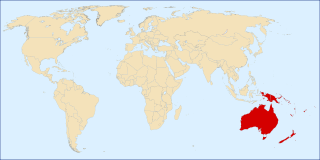
The following outline is provided as an overview and topical guide to Oceania.
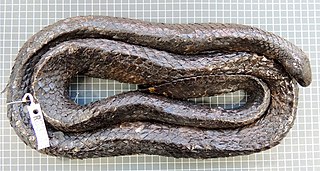
Aipysurus apraefrontalis, commonly known as the short-nosed sea snake or Sahul reef snake, is a critically endangered species of venomous sea snake in the family Elapidae, which occurs on reefs off the northern coast of Western Australia. English herpetologist Malcolm Arthur Smith described the species in 1926 from a specimen collected on the Ashmore Reef.
Aipysurus fuscus, commonly known as the dusky sea snake or Timor Reef snake, is a species of sea snake in the family Elapidae. It is found in the Timor Sea between Australia, Indonesia and East Timor and has been classified as endangered.
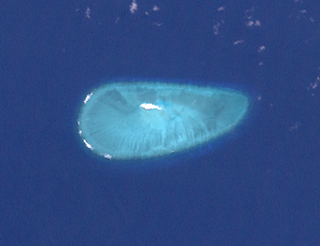
The Cartier Island Marine Park is an Australian marine park that covers the Cartier Island and reef surrounds, about 610 km (380 mi) north of Broome, Western Australia. The marine park covers an area of 172 km2 (66 sq mi) and is assigned IUCN category Ia. It is one of the 13 parks managed under the North-west Marine Parks Network.

The Ashmore Reef Marine Park is an Australian marine park that covers the Ashmore Reef, which is located about 630 km (390 mi) north of Broome and 110 km (68 mi) south of the Indonesian island of Rote. The marine park covers an area of 583 km2 (225 sq mi) and is assigned IUCN category Ia. It is one of 13 parks managed under the North-west Marine Parks Network.
Australian online fauna & flora databases: Both the Commonwealth of Australia and its various states maintain a number of online databases which encompass both native and naturalised fauna and flora. Some are taxonomic. Some are descriptive. Some are both. Some indicate threatened or nuisance species. The list below is incomplete.
References
- Kenneally, Kevin F. (1993). "Ashmore Reef and Cartier Island". Flora of Australia: Volume 50: Oceanic Islands 2. Canberra: AGPS Press. pp. 43–47. ISBN 0-644-14446-7.